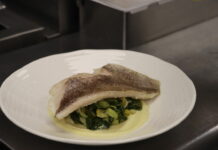My sweet tooth craves a little sour; I find that in fruit, as in people, too much sugar can be cloying. At the Waverly Farmers’ Market each summer, I pass by the tables piled high with frosty plums, ripe peaches and melons and head straight for the tables that offer the promise of the season’s first apples. I scan the hand-lettered signs, eschewing the pretty, preening and shiny Red Delicious (which is tarted up in looks but not in flavor) and the dime-a-dozen Gala in favor of the eyebrow-wiggling tang of older varieties like Jonathan and Winesap. Or even a green, under-ripe Golden Delicious.
I love apples for their acidic crispness— that raw, zingy crunch that makes your gums quiver— and for their constancy. Although best in autumn, apples withstand cold storage to stand by you in the gloom of January and withstand heat to bring you a preview of fall even in July.
I also love their poetic names— the old-fashioned “Bottle Greening” or the French Calville Rouge d’Automne— and their peculiar reproductive habits. For example, the seeds of any given apple, according to Michael Pollan’s wonderful book “The Botany of Desire,” are genetically programmed to reproduce apple offspring that are entirely, varietally, different from the parent apple. This is called heterozygosity. If not for grafting or cloning, Pollan explains, “every apple in the world would be its own distinct variety, and it would be impossible to keep a good one going beyond the life span of that particular tree.”
But more than anything, I love the apple for the culinary companionship it has provided throughout my life. My relationship with apples started in infancy, I’m sure, in a jar of baby applesauce. And each October as a small child, my family, braving my dad’s cigar and my motion sickness, would squeeze into our gold Chrysler to make the annual hour-long trip to Stewartstown, Pa. There we would buy a bushel or two of apples from Barton’s Orchards.
My mother reminds me that one year we picked the apples ourselves. I have no memory of this. Instead, I recall the intense blue skies (not the gothic gray skies I usually associate with autumn) that seemed to coincide with every trip to Stewartstown, and the corduroy pants and wool sweaters pulled right from the cedar chest storage that we would wear for the trip.
And I remember Barton’s, with its country-cute store that sold honey-bears and multi-colored sticks of candy in old-fashioned flavors like horehound and sarsaparilla, as well as apples. My mother and grandparents would wander through the rows of apples— some in squarish paper bags with white handles, some in cone-shaped baskets— inspecting and selecting the fruit they’d later transform into applesauce, apple butter, apple jelly and apple pies. My father, sister and I would troll through the candy jars playfully arguing over what combination of 10 candy sticks we would buy for a dollar.
Late in the day, we’d return to Baltimore with a trunk full of Winesaps, our mouths watering in anticipation of our post-outing traditional dinner: apple fritters. Mom and Grandma dipped apple slices in a light batter reminiscent of the kind used for funnel cakes, dropped them into the deep fryer, plucked them out and sprinkled them with powdered sugar. They would then sizzle on our plates next to crispy, celery-seeded sausage cakes. Cholesterol be damned. If apple fritters will kill me, let me go.
Apples followed me to my first paying job at Weber’s Farm on Proctor Lane in Carney, where I soaked through my pointy Keds cleaning the massive stainless steel cider tank and pumped countless frozen cider slushes at the annual Johnny Appleseed Festival. Those days at Weber’s were so full that at night, apples would invade my dreams. They fell through my hands as I graded good fruit from bad and appeared ghost-like on the produce scales. But this invasion never dimmed my love for the fruit.
The first pie I ever made, probably around age 10, was apple with a simple Crisco crust, baked in a mini-pie pan. From there, I graduated to a recipe from Southern Living, an open-faced apple pie with cheddar cheese in the crust that I made over and over again when I was in high school. Before long, my clippings notebook was bursting with apple pie recipes, and it still is. I have recipes for apple pies made with sour cream in the filling, made with calvados and phyllo dough, streusel crumbled and lattice topped, double crust and open face. My latest love is tarte tatin, a tour de force of butter, sugar and apples.
Barton’s has closed, and these days I usually buy my apples from the farmers’ market in pounds rather than bushels. My mother has sworn off the fuss of canning, though I long to be her accomplice in that process. And I find that apples have crept out of the pie plate and into all aspects of my cooking— from breakfast oatmeal and French toast to a savory chicken and prune dish and a cream sauce for roast pork. Some folks put apples in their Thanksgiving bread stuffing, and I always throw one into my sauerkraut. They are dilettantes, these apples, the fruit embodiment of my own desire for versatility. Perhaps that’s another reason why I love them so much.
Chicken with Sausage, Prunes and Apples




